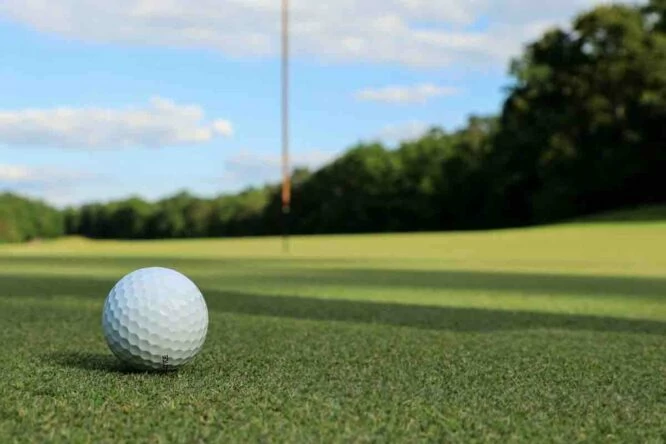
This is an excellent time to learn golf, and if you’re reading this, you’re probably interested in the game. Golf is ideally suited to today’s social-distancing world. It’s a game played over a large outdoor area, a meaningful and rewarding source of exercise, and a mental diversion. To truly appreciate golf, however, you must overcome all the intimidating factors that may have kept you away up to this point.
To the uninitiated, golf can appear to be a very complicated sport. There are so many rules and different types of clubs. Then there’s the jargon: bogeys, birdies, and bump-and-runs, to name a few. At golf magazines, they speak this terminology every day, but we also know it can turn off prospective golfers before they even pick up a club. This is where this interactive beginner’s guide comes in handy. Our goal is to guide you through this uncertainty.
What Is a Golf Handicap?
A golf handicap is a number that indicates a golfer’s skill level. A golf handicap is calculated by prior scores and varies from player to player. Your golf score is calculated using a system that varies from year to year. The most recent handicap calculator can be found on the official USGA website. To calculate your handicap, you must have played at least one round of golf on a 9- or 18-hole course and have your scorecard handy.
Clubs to Choose From
In the broadest sense, your clubs will tell you when it’s best to use them. Each club is designed to do a specific job, which is to send the ball a specific distance at a specific trajectory. Your bag’s longest clubs- Fairway Woods, the Driver, and Hybrids, have less loft on the face and longer shafts, allowing the ball to travel further. As you advance from a 5-iron to a Sand Wedge, the shafts become shorter, and the loft on the face increases, causing the ball to travel shorter and descend more steeply.
Average Golf Club Distances
If you’re new to golf, you’ve probably wondered how far you should be hitting the ball in terms of average golf club distance. The answer varies depending on where you look because it is dependent multiple factors.
The standard distances with each golf club will change depending on the golfer’s skill and the club. A PGA professional, for example, can hit a driver 300 yards, while the typical male amateur can only smash the ball 230 yards.
The LPGA pros’ shots are typically hit at average driving distances of roughly 250 yards. Other golf clubs, such as irons and wedges, will typically have a much shorter yardage. However, a beginner who merely plays for fun may only be able to attain the 200-yard target at most. As you can see, the average distances of golf club types differ. Therefore, you should have a golf club distance chart on hand to help you figure out what information to look for.
What is The Absolute Bare Minimum for Playing Golf?
One of the most intimidating aspects of learning to play golf is being unsure of whether you’re using the proper clubs. The key to starting slowly but tactically with equipment, as with most things in this sport, is to take it slowly but strategically. First, even if most players eventually get there, there’s no reason to start with 14 clubs in your bag. You can begin with a few and work your way up.
You will require golf balls, but at this moment in your golf career, my suggestion is to pay less and buy used balls before graduating to new ones. When you stop losing too many in a round of golf, you can try to be a little pickier. Other essentials that I believe are important include:
Golf bag: When you’re not quite certain about golf, ask a friend who regularly plays because they’ll have a lot of extras that you can borrow. That should suffice for the time being and save you some money.
Tees: Buy a pack of 20, and you won’t need to buy tees as often. A divot/pitch repair tool for repairing pitch marks on the green will come in useful once your iron shots start hitting greens more frequently, and you’ll earn goodwill with your playing partners because repairing pitch marks on the green is always good etiquette.
Towel: This is useful for keeping your clubs clean. This also helps to keep you dry and can be used as a wet wipe on the course during the summer to keep you cool.
Many driving ranges also provide rental clubs, so you may prefer to rent, to begin with, and then gradually build up your set of golf clubs once you are certain you will continue to play the sport.
OK, I tried it, and now I’m hooked. What should I do with my equipment next?
It’s a matter of determining how much of a commitment you’re willing to make. And by commitment, I mean the amount of money you are willing to spend. If you don’t want to spend a lot of money, purchase used clubs or rent extra clubs from a fellow.
Fundamentals of the golf swing
The golf swing is a series of events, and how you set up to hit a golf ball is among the most essential parts of the play, and where 90% of novices fail. Hitting a golf ball will become a lot easier if you get your setting right.
There are three easy steps to remember: G-A-P
- Grip
- Aim
- Posture
If you master these three golf swing fundamentals, you’ll be well on your way to hitting some great golf shots.
What Are the Golf Rules?
Golf has many unique rules, but for a beginner, it’s all about knowing how to contend in a stroke-play game. So here are some things to remember to avoid being kicked off the course:
- There’s No Defense
Even if the competition is fierce, you cannot block a player’s shot or intrude with the game. It’s not cool to try to sabotage someone else’s game simply because you can’t get that hole-in-one.
- Carry no more than 14 clubs
During a challenging round, you may carry up to 14 clubs in your bag. If you bring any extras, you may be assessed penalty strokes for each hole you play.
- Playing Order
The player who is farthest away from the hole is the first to strike. Keep going in this way until you achieve the putters, at which level place the closest ball first.
- Preliminary Ball
If your ball is unplayable (for example, if it is underwater or in a bush), you are permitted to hit a ball from your initial place. This maintains the pace of play and helps to give you a fair chance.
- Follow the Dress Code
Some golf clubs impose a strict dress code that you must adhere to. In other words, don’t expect to be allowed to play if you arrive in a banana suit. Dress modestly and neatly when in doubt.
- The Ball Rolls Off the Tee
If the ball falls off due to wind or another uncontrollable factor, you can re-tee it. If, on the other hand, you completely whiff and the ball falls as a result of the air, you must play the ball as it lies.
- Unplayable Deceptions
There may be obstacles on the course, such as errant golf carts, shrubs, or animals. In these cases, you may be able to get a free drop, allowing you to relocate the ball fairly.
- There will be no joy rides in the golf cart
A golf cart, like any other vehicle, is considered a mode of transportation. This means that if you do not obey traffic laws, signals, and signs on the road, you may face citations, fines, or the loss of your license.
- Penalties for a single strike
This is when a stroke is added to your score even though you did not take a swing. If you end up losing a ball, it goes outside of bounds, there is a water hazard, or you unintentionally or intentionally move a ball, you will receive a one-stroke penalty.
- Penalties for two strikes
A two-stroke penalty is considered a more serious offense. This penalty may be imposed during a game if you play the incorrect ball or even if you seek advice during a highly competitive round!
Golf Course Terminology
Golf Tee – The wooden peg at the start of the hole where you put your golf ball.
Golf Tee Box – The area where you first hit the ball at the beginning of the hole is known as the golf tee box.
Fairway – The section of the golf course which leads to the green and is usually where putting occurs.
The green – refers to the soft, plush ground that surrounds the hole.
A bunker – is a sand-filled ditch that typically surrounds the green.
The rough – is rough on either side of the fairway. This area is frequently densely forested and covered in the long grass.
Hazard – Ponds, streams, bunkers, and trees are all potential hazards. Anything that stands in your way of successfully putting the golf ball into the hole.
Typical Golf Etiquette
Although golf is a competitive sport, there are basic rules and etiquette that must be abided by on the course. These principles are expected to be obeyed at all golf courses, even though they are not found in the official rule book.
- Don’t interrupt someone’s backswing.
- Do not cross someone else’s path (the line from their ball to the hole).
- Don’t hit the ball into the group in front of you. Wait for them to complete their task.
- Consider letting the group ahead of you go first at the next hole if they are playing faster.
- Avoid irrational outbursts.
Conclusion
For hundreds of years, golf has been a popular pastime. It’s a sport that requires skill as well as precision, but it’s also relaxing and simple to play if you’re going to catch up with friends or looking to spice up a business meeting.
Golf is enjoyed by an estimated 23.8 million people in the United States alone. Whether you go to the mini-golf course or the full 18 holes, it’s a pleasurable way to spend an afternoon in the sun!



